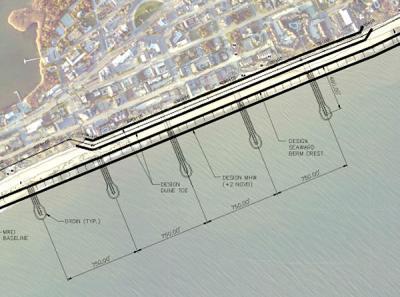Army Corps Pitches Montauk Beach Options

A federal erosion-control and beach rebuilding project for downtown Montauk, which could include an 11-foot-high buried seawall or five rock groins, or jetties, jutting into the ocean along a more than half-mile stretch, will be discussed by the Army Corps of Engineers this morning at East Hampton Town Hall. The meeting begins at 11.
Details were few, and maps provided to town officials by the Army Corps were still being reviewed earlier this week.
The options apparently include, besides the buried seawall or groin field, several versions of a beach rebuilt without hard structures installed.
However, at a meeting with federal, state, and local officials in August, Army Corps representatives reportedly indicated that they had determined that merely rebuilding a beach and dunes in the downtown Montauk area would not be cost-effective.
The Army Corps has set a December goal for approval of a final plan, and work could begin in the new year. The project is included in a federal effort known as the Fire Island to Montauk Point Reformulation Plan, which has been five decades in the making, with federal funding of the proposed projects therein a perennial question.
However, federal funds became available following Hurricane Sandy, as part of a relief package approved by Congress, and the Montauk project would be 100 percent federally funded. Of a $700 million allocation for the Fire Island to Montauk stabilization project, $140 million has been earmarked for the reconstruction of vulnerable beaches in Montauk and on Fire Island, both considered emergency measures.
For “non-structural alternatives,” such as elevating shoreline buildings and roadways, $500 million has been earmarked, and $60 million of the total has been targeted for “green” infrastructure within “embayment” areas.
East Hampton Town’s local waterfront revitalization project plan, a state-approved coastal policy document, precludes the use of hard structures like seawalls or jetties along the Atlantic Ocean coast. Only the addition of sand or textile “geotubes” filled with sand is allowed in the ocean zone, according to that plan.
Earlier this year, with federal funding for a beach-rebuilding project in Montauk still a question, Town Supervisor Bill Wilkinson had pressed the town board for a blanket approval of any Army Corps plan for the area. With the exception of Town Councilwoman Theresa Quigley, however, board members said that review of a proposed plan, perhaps by an independent coastal engineer, would be warranted.
Recommendations from a coastal erosion committee set up by the town this year included protecting the Montauk commercial district and the Ditch Plain beach by adding enough sand to create a 2.3-mile, 200-foot wide “engineered” beach.
“We don’t want to have an armor across the downtown commercial district,” Drew Bennett, a member of the committee, told the town board earlier this year. “We admit, if we fail, that’s what we’ll have.”
The committee also recommended that the town, in collaboration with the state and federal governments, develop a buyout plan for shoreline properties in peril, whose owners may be willing to sell. The program could use money from the community preservation fund, the committee suggested.
News of today’s meeting was circulated by several community groups that have urged residents to attend, including the Eastern Long Island Chapter of the Surfrider Foundation and the Concerned Citizens of Montauk.
“After 40 years of the Army Corps working on F.I.M.P., C.C.O.M. looks forward to finally seeing some of the details of what the Army Corps is proposing to do,” Jeremy Samuelson, the executive director of the Montauk group, said Tuesday. “It is critical to the public interest that the Army Corps spell out in detail what the timelines and opportunities for expert municipal and public input will be as a part of this process,” he said.
